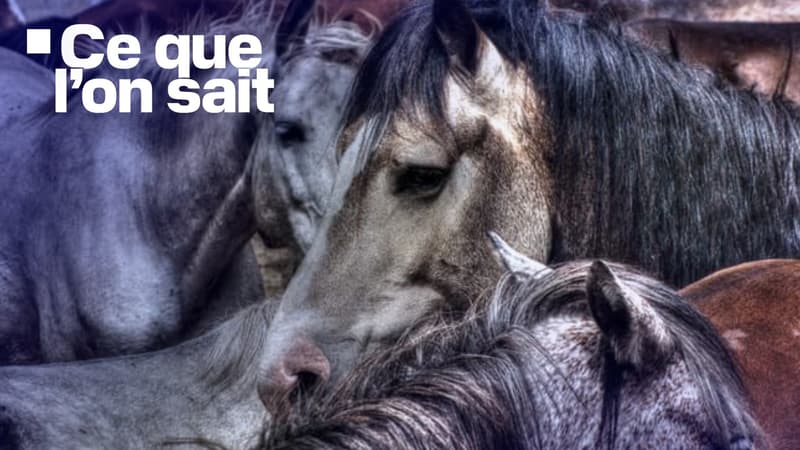Concern in the stables. An epidemic of equine rhinopneumonia has affected France since mid-November. Ten horses died from this highly contagious disease. The equine disease surveillance network calls for “the greatest vigilance” as the competition season is in full swing and the Paris Equestrian Show opens this Friday, December 6 after a five-year absence.
• A very contagious disease, with more or less severe forms.
Equine rhinopneumonia affects – as its name indicates – horses, ponies and donkeys. It is a very contagious disease that occurs in three forms, respiratory, abortive or nervous, more or less serious.
The respiratory form, which is characterized by hyperthermia, cough or discharge (runny nose), is the most common and the least dangerous for the animal. On the other hand, this disease is more problematic when it is abortive in mares, or when it is nervous and leads, among other things, to paralysis.
The disease “can cause the horse to die naturally or require euthanasia,” says Jean-Marc Betsch, also treasurer of Respe.
Horses contaminate each other through secretions, whether respiratory or urinary. Therefore, they can become contaminated when they share a box, a truck, a watering hole, etc. If equine rhinopneumonia does not affect humans, humans can be vectors of this virus, just like dogs. “Man is an important vector of the virus,” says the equine practitioner. “If the horse sneezes in your hair, you can contaminate another animal without knowing it.”
• Nine outbreaks recorded, at least 70 horses contaminated
The Equine Pathology Epidemiological Surveillance Network (Respe) registered, until December 2, nine outbreaks in France. More precisely, this network that brought together a crisis unit detected three outbreaks in Essonne, two in Hauts-de-Seine, one in Yvelines, one in Eure-et-Loir, one in Loire-Atlantique and finally one in Orne.
“To date, the circulation of the virus remains active in the outbreaks already identified in the Ile-de-France and in the outbreaks identified last week in Loire-Atlantique and Orne,” the statement indicates.
Before adding: “One of the outbreaks in Ile-de-France registered several new positive horses (…) and the outbreak in Loire-Atlantique, more recent, saw an increase in the number of horses presenting with hyperthermia.”
“There have been new outbreaks for a week, it is circulating a lot, we must be careful,” says Christel Marcillaud-Pitel, director of Respe, contacted by BFMTV.com.
So far around 70 infected horses have been identified. “But, in my opinion, there is more than that,” he emphasizes, specifying that the majority of these cases are not serious. Respe “deplores” ten deaths in total.
A crisis unit will meet early next week to assess the situation.
• The starting point? A competition in Sarthe
If “it is always difficult to know the zero horse”, according to Christel Marcillaud-Pitel, it has been proven that this epidemic originated during a competition at the beginning of November in Sarthe.
“More than 1,000 horses from all over France participated in this meeting, a priori there was one that was sick or incubation,” says the president of the surveillance network that brings together more than 1,000 veterinarians in the territory.
“The first outbreak in Ile-de-France is related to this competition,” he says. The virus then spread especially during a second competition in Seine-et-Marne in mid-November.
If outbreaks are recorded throughout the year, since 2018 there has been approximately one epidemic situation per year, according to Christel Marcillaud-Pitel.
“We do not know why epidemics have been more frequent in the last six years, but this may be related to the fact that there are more and more horse gatherings,” says the director of Respe. “Before there was a period of pause in the competitions, during the winter period this is no longer the case. There are competitions all the time and more and more horses gather,” he adds.
In France, the last major epidemic dates back to 2018. At the European level, it dates back to 2021. “There was a big competition in Valencia. When the horses returned to their respective countries, they spread the disease throughout the continent,” he explains. Jean-Marc Betsch, equine practitioner in Normandy and vice-president of the Equine Veterinary Association.
• Equestrian meetings under close surveillance
Equine rhinopneumonia “is like Covid” in humans image Jean-Marc Betsch. “We’re trying to limit its spread from one department to another.” It is therefore necessary to isolate sick horses. “We must immediately report the case,” emphasizes the vice president of the Equine Veterinary Association, recalling Respe’s “leitmotif,” “to report is to protect.”
Owners must be very attentive before and after any meeting. “You have to take your temperature regularly,” insists Christel Marcillaud-Pitel, who would like this gesture to become a “reflex” throughout the year.
The Respe crisis unit even calls for “the cancellation or postponement of all competitions and meetings of ponies or sport horses until December 15 inclusive.”
Another pillar of prevention: vaccination, which reduces the contagiousness of the virus. “Horses are not sufficiently vaccinated against this disease, only between 30 and 40% are, while for there to be collective protection it would be necessary to vaccinate more than 80% of them,” explains the president of Respe.
“If the horses were vaccinated correctly, the economic impact would be less,” emphasizes Jean-Marc Betsch. In fact, the disease has caused the closure of some equestrian centers and prevents certain meetings. In 2019, equine activities generated more than 11 billion in financial flows, of which 9.8 billion in horse racing and one billion in sports-leisure, indicates the French Horse and Equestrian Institute (IFCE) in its website.
Source: BFM TV


